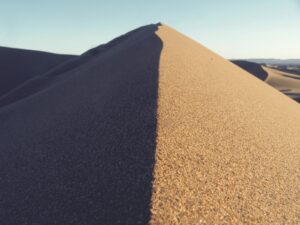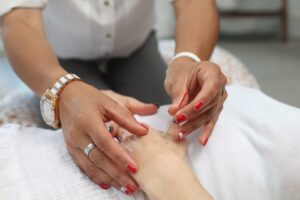Subscribe to the Newsletter
If you are interested in understanding how Traditional Chinese Medicine can improve your life sign up to my newsletter for the latest updates.

Key Learning Points
Luo-connecting channels provide a network or web that interlaces all parts of the body, emanating outwards or sideways, from the main or primary channels. This web lets one primary channel reach through to its partner.
This web or network is at two different levels, superficial and deep. The superficial network is seen in the small veins that appear during disease or after trauma, showing inflammation or blockage. This level lies just under the skin.

The deeper part is where chronic disease may end up, stuck in the ‘Blood level’ deep in the body. This Blood level is not so much at a depth measurable in inches or centimetres but in terms of seriousness, ie harder to cure.
Actually, the Chinese classics are much more precise than this.
They say that a pathogenic factor, ie something that causes illness, (in Chinese medicine this would be described as one or more of Wind, Cold, Damp etc) first invades the skin giving you goosebumps, it then reaches the level of the superficial luo-connecting channels causing pain in the muscles.
Then, unless expelled by your body or after appropriate treatment, it penetrates into the primary acupuncture channels, giving further pain along them, then to the Chong Mo with digestive problems, invading the membranes deep in the body cavities.
It then passes to the Blood vessels in the deep luo-connecting channels, where you may get Blood stasis, with masses, tumours, lumps and bumps.
The other usage of the term relates to discrete channels, rather like the primary acupuncture channels, which depart from specific points on the primary channels, called the luo points, or luo-connecting points, or junction points.
Each has a trajectory different from the primary channels.
This type of luo-connecting channel is what is usually meant by acupuncturists when they talk about luo-connecting channels.
The pathway of these luo-connecting channels is really useful for acupuncturists. It makes the luo-connecting points very dynamic in their action. This means that they can powerfully affect the areas covered by the luo channel.
Well, of course, it all happened thousands of years ago, so nobody knows for sure! Here’s what we surmise …

Possibly, the original idea behind the luo-connecting points was that they described what happened to the skin and flesh when injured. This could be from trauma or when someone got acutely ill, say from what we now describe as an infection.
Under these circumstances, capillaries and smaller veins becomes swollen, and newly and temporarily visible. (These are quite distinct from the large veins which stand out naturally in people who are either thin or getting old.)
The Chinese solution to this kind of vein was to release the internal pressure in these ‘wounded’ or inflamed areas. Bloodletting – still an important treatment method – incised these new, temporary swollen veins and squeezed out some of the blood collected there.
As a result of the trauma, this blood was circulating only slowly, so had a darker hue. It was said to be stagnant. Later on in the development of Chinese medicine, this idea led to deeper ideas about Blood and Blood-Stasis.
By bleeding the vein, new blood was able to reach the area and move through it faster than the stagnant blood it replaced, leading to faster healing.
Sometimes they cupped over the initial incision, to allow more blood to flow. (This is ‘wet-cupping’. For various reasons, including danger of infection, don’t do it unless you know what you are doing and are insured.)
Those tiny veins and capillaries that subsequently sank back into invisibility showed a wealth of connections under the skin. The word the Chinese used for this was ‘luo’, meaning ‘network’.
Later, they discovered certain acupuncture points on each acupuncture channel with a particular influence on specific areas of the body. These became known as the luo-connecting points.
In time, they realised these points had other properties. A whole theory, or set of theories, developed about them.
The first idea was the one explained above, that the luo channels covered the relatively superficial areas just under the skin, over or bordering the line of the main channel in question. As such, they explain areas that swell up in acute disease. Parts of this theory developed in later centuries to explain what happens when the channels are exhausted or empty.
This network idea means that each channel reaches out through the flesh to other adjacent channels, and particularly to its partner channel. For example, Lung and Large Intestine channels, or Spleen and Stomach channels.
The luo-connecting points can be used to help push out acute disease from the body. This applies particularly to those zang-fu that have most to do with the defence of the exterior of the body, including the skin, the nose and the lungs. Hence the Large Intestine Yang Ming channel, the Three Heater Shao Yang channel and the Lung Tai Yin channel (the Lungs are said to ‘rule the skin and pores’).
The luo-connecting points can transfer Qi between the channels. If one is ‘full’ the other may be ’empty’, and these points are points of transfer. This is mainly useful when after a disease has passed there remains still a disparity, with symptoms indicating fullness in one of a pair and emptiness in its partner. This is named the ‘host-guest theory’, quite often used clinically.
It goes further. Sometimes we use the luo-connecting points to transfer energy from one side of the body to the other. The most common use of this, however, is to treat a pathogenic factor on one side of the body by using the luo-connecting point on the other side of the body. (This is where channel pathway knowledge is important because you need to know which channel is affected.)

Each Luo-connecting channel has its own deep pathway, no doubt discovered much later when they were mapping out all the primary acupuncture channels and their points. This pathway often bears little resemblance to the superficial pathway of its own primary channel. These deeper pathways and where they reach can be useful clinically.
This means that each luo-connecting point has its own channel pathway, controlled, or at least influenced, by its luo point. Sometimes the description of the pathway is short, but sometimes it makes the use of that point very significant, either alone or as part of a treatment. For where each of these luo-connecting channels goes and what it does, click on the links below.
Because the superficial luo-connecting channels are just under the skin, they carry the body’s Wei or Defensive Qi. (Qi from what you eat, after being transported to the Lungs, becomes either Defensive Qi or Nutritive Qi, the latter being carried mainly by the Primary channels. Defensive Qi is carried by the luo-connecting channels.) This is important because as mentioned above, the luo-connecting points can be used to stimulate this defensive Qi to push out invading pathogenic factors like Wind.
Defensive Qi, being Yang, also warms the muscles and regulates the temperature of the body. At night, during sleep, Defensive Qi goes into the body’s Yin interior which nourishes and re-invigorates it.
So, if you don’t get enough sleep, your defensive system is less effective AND you’ll tend to feel colder during the day. Make sure you get your sleep! (Of course, if you don’t eat enough, or you eat badly – see Nutrition – you won’t have enough Qi in the first place to make either Defensive or Nutritive Qi. In that case you’ll not only feel cold but you’ll also be undernourished.)
The name ‘connecting’ suggests yet another use, that of harmonising the interior and exterior. So we use many of these points to steady and regulate the body, for instance by calming the mind.

Stay in Touch!
No spam, only notifications about new articles and updates.

Book a Video consultation if you want to know more about your symptoms
Like all groupings of acupuncture points, (eg xi-cleft points, exit/entry points, etc) ways of treating them are sometimes easy to describe, sometimes less so.
The luo-connecting points have many uses. There are many ways to use them. For example:

This Introductory Chinese medicine course introduces you to the amazing thinking behind this ancient medicine, now increasingly in demand.

The Scottish College for Chinese medicine provides introductory courses for all, explaining Chinese medicine and its cultural background.

Master Tung’s acupuncture is a hidden treasure, lost to China but recovered in Taiwan from where it spread round the world.

Knee pain has five main causes. It’s certainly worth trying acupuncture before you resort to surgery!
Subscribe to the Newsletter
If you are interested in understanding how Traditional Chinese Medicine can improve your life sign up to my newsletter for the latest updates.
Subscribe to the Newsletter
If you are interested in understanding how Traditional Chinese Medicine can improve your life sign up to my newsletter for the latest updates.